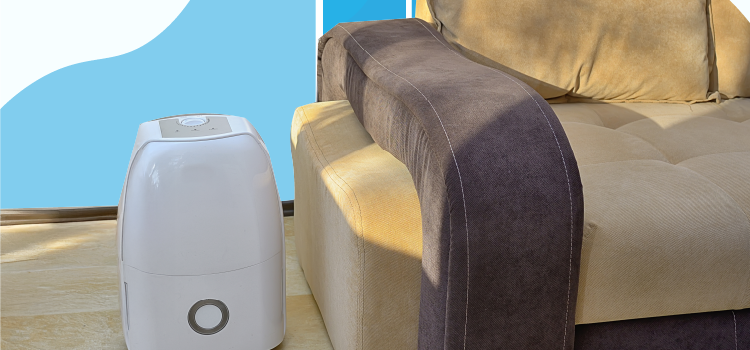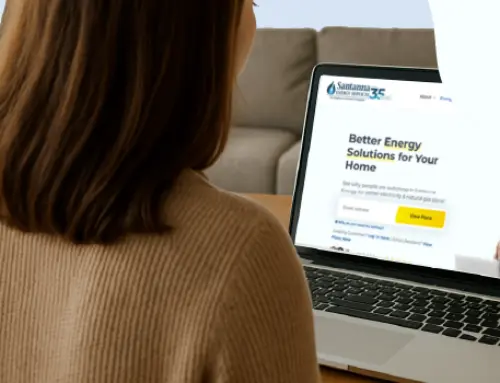What Size Dehumidifier Do I Need
by Tyler Castle
20.5 min read

Humidity plays a bigger role in your comfort and indoor air quality than most people realize. When your home feels damp, sticky, or musty — it's often a sign that excess moisture is lurking in the air. That's where a dehumidifier comes in. Unlike humidifiers, which add moisture to dry air, dehumidifiers are designed to remove excess humidity, helping you create a healthier, more comfortable living space.
But here's the catch: choosing the right dehumidifier size matters. Get one that's too small, and it'll struggle to keep up — running constantly without ever fully drying the air. Get one that's too big, and you could waste energy and overspend unnecessarily.
But don't worry, we'll walk you through how dehumidifiers work, signs your space needs one, when to use it, and — most importantly — how to decipher what size dehumidifier you need for your home. Let's clear the air (literally) and make sure you're breathing better at home.
What’s the Difference Between a Humidifier and a Dehumidifier?
Want to know what’s the difference between a humidifier and a dehumidifier? The difference is as simple as the air we breathe!
For starters, a humidifier adds moisture to the air and it’s especially helpful during the colder months when indoor air tends to get really dry. It prevents influenza and reduces snoringoo! It works by turning water into mist or steam and releasing it into the air, which can soothe your airways, reduce coughing, and even help with scratchy throats.
In the same way, if you have issues with controlling your indoor humidity, humidifier can help by keeping your indoor humidity at the ideal levels for your home — between 30% and 50%.
There are several types of humidifiers, each with its own way of doing the job keeping your home at its ideal moisture levels. Here are some of the most common to investigate if you’re purchasing a model for yourself:
Central humidifiers are built right into your home’s heating and cooling system. They automatically add moisture to the air throughout the entire house, so you don’t have to think about it.
Ultrasonic humidifiers use sound vibrations to produce a very fine, cool mist. They’re super quiet, which makes them perfect for bedrooms or nurseries.
Impeller humidifiers use a fast-spinning disk to release cool mist into the air. Since there’s no heating element involved, they’re generally safe to use around kids.
Evaporative humidifiers work by blowing air through a wet filter or wick. It’s a natural way to increase humidity and is often very effective for medium-sized rooms.
Steam vaporizers heat water to create a warm mist. They’re great for clearing up congestion, but because they boil water, they can be a burn risk — so they’re not the best option if you’ve got young kids around.
If you’re wondering what’s the difference between a humidifier and a dehumidifier, let’s flip the coin. A dehumidifier on the other hand removes extra moisture from the air — which is especially helpful in humid climates or in damp areas like basements, bathrooms, and laundry rooms. If you’ve noticed a musty smell, mold spots, or that sticky, heavy feeling in the air, a dehumidifier can help dry things out and make your home feel fresher and more comfortable. Dehumidifier can also reduce allergens and ease breathing, especially for people with allergies or asthma.
As a bonus, according to Energy Star, an ENERGY STAR-certified dehumidifier uses 14% less energy than standard models while removing the same amount of moisture. That means you can lower humidity efficiently while also saving on electricity bills! Here are a few different types of dehumidifiers to keep an eye out for if you’re looking to make a purchase:
Refrigerant (or Compressor) Dehumidifiers are the most common type and work best in warmer, humid environments like basements. They use cold coils to condense moisture from the air and are great for removing large amounts of humidity quickly.
Desiccant Dehumidifiers use moisture-absorbing materials (similar to silica gel) to pull humidity from the air. They perform well in cooler temperatures where refrigerant models might struggle.
Hybrid Dehumidifiers combine refrigerant and desiccant technologies, making them more versatile across different temperatures and humidity levels.
Ionic Membrane Dehumidifiers are newer, quieter, and more low-maintenance options. They use electrolysis to remove moisture and are often found in specialized or commercial applications.
Peltier (Thermoelectric) Dehumidifiers are perfect for tight spaces like closets, bathrooms, or RVs. While not as powerful as other types, they’re energy-efficient for small-area use.
Do I Need a Dehumidifier?
If you’re wondering whether your home might need a dehumidifier, a good first step is to look around and trust your senses. Some signs of high humidity are pretty obvious — like water stains on your walls or ceilings, condensation on windows, peeling wallpaper, or paint that’s bubbling or flaking. You might also notice musty smells, or that your home just feels heavy, damp, or stuffy. If your home shows any of these signs, a dehumidifier can do the trick to soak up any lingering moisture and stop further household damage.
Another reason to consider a dehumidifier is allergies. Moist air creates the perfect breeding ground for things like mold, mildew, and dust mites, which can trigger sneezing, congestion, and other allergy symptoms. Lastly, if you’re feeling congested or having trouble sleeping because of a lingering cold, a dehumidifier can sometimes help open up your breathing and make it easier to rest.
Even if no one in your home has allergies, mold is a serious issue. It only takes a little moisture for it to start growing, and once it’s there, it can damage furniture, walls, or anything it clings to. And mold is a pain to remove once it sets in, so it’s better to prevent it in the first place. Plus, bugs love moisture too. Roaches, silverfish, centipedes, and even spiders are more likely to move in if the air in your home is damp. Drying things out with a dehumidifier can make your space way less appealing to pests.
If your home is experiencing any of these issues or your allergies are regularly unkind to you, a dehumidifier might need a dehumidifier in your home.
When to Use a Dehumidifier
Understanding when to use a dehumidifier can make a huge difference in your home’s comfort, air quality, and even long-term maintenance. For instance, if allergy symptoms linger year-round or worsen after a move, excess humidity could be to blame, encouraging mold, mildew, and dust mites.
A musty odor that never goes away, wet floors or walls after rain, or air that feels thick and sticky are also clear signs of high moisture levels. You might notice dust mite allergies flaring up, more pests like roaches or silverfish, or even laundry that smells funky and won’t dry properly. Persistent respiratory symptoms like coughing or congestion may also be linked to high humidity. In all these situations, using a dehumidifier can make a big difference.
What Size Dehumidifier Do I Need?
If you’ve figured out by now that a dehumidifier is right for you, it’s important to note that sizing is crucial if you want it to work efficiently. A unit that’s too small will run constantly without effectively lowering the humidity, while one that’s too large may waste energy and cost more than necessary. Here’s how to correctly figure out what size dehumidifier you need for your home:
Step 1: Measure the Size of Your Room
Choosing the right dehumidifier for your home depends on two key factors: the size of the space (in square feet) and how much moisture is in the air. For the best results, place the dehumidifier in a single room and avoid moving it from one area to another.
You can measure your room with a simple measuring tape. Be sure to measure the length and width of the room (in feet) to get the total square footage of your room. This information is helpful to have when figuring out what size humidifier you need because most humidifier sizing guides are based on the square footage of the room they’ll be used in.
Once you’ve found your room’s length and width, multiply these numbers together to get your room’s square footage. As an example, if your room is 10 feet wide and 15 feet long, your room measures at 150 square feet. If your space isn’t a perfect rectangle, break it into smaller sections, measure each one, then add them up.
Step 2: Measure Your Rooms Humidity
Measuring your indoor humidity levels gives you a clearer picture of what your home truly needs—not just what it feels like. You can start by using a hygrometer which is specifically designed to measure the amount of moisture (humidity) in the air. It gives you a percentage reading of relative humidity (RH).
To do this, proper placement matters. Place your hygrometer in the room you want to monitor, about 4–6 feet above the ground for an accurate reading. Keep it away from direct sunlight, heaters, vents, kitchens, or bathrooms — these areas can cause artificial spikes in humidity readings. Avoid placing it near windows or exterior walls where temperature changes rapidly.
Taking a Reading
Once you’ve placed your hygrometer in the room, give it a few hours to stabilize in its new environment. Most digital models will then display a real-time reading of both humidity and temperature. This measurement is an important part of determining the dehumidifier you need, since knowing your exact indoor humidity level helps you choose a unit that can handle the moisture in your space effectively.
Alternative (Less Accurate) Methods for Testing Your Humidity Levels
If you’re still wondering what size dehumidifier do I need? and you don’t have access to a hydrometer, try these methods:
Wet and Dry Bulb Thermometer Method
To measure humidity with two thermometers, leave one dry and wrap a damp cloth around the other. Place both in a ventilated spot with airflow on the wet bulb. After 5–10 minutes, record the temperatures. Subtract the wet bulb from the dry bulb or use a psychrometric chart or an online humidity calculator to find the relative humidity based on your results.
The Ice Cube Method
For a quick humidity check, fill a clear glass with water and 4–5 ice cubes. Place it in the room for 3–5 minutes, away from heat sources. If condensation forms on the outside, the air is humid. If not, the room likely has low humidity. While this method isn’t the most precise for determining the right dehumidifier size, it can give you a helpful baseline for understanding your home’s humidity and what conditions might be most comfortable with your new dehumidifier.
Estimated Dehumidifier Size You’ll Need Based on Room Size and Average Moisture Conditions
While dehumidifiers come in different sizes, here’s what size dehumidifier you might need based on your room size:
Small Rooms (Up to 300 Sq. Ft.) – 20 to 30 Pint Dehumidifier
If your space just feels a little damp or has mild humidity issues, a 20–30 pint unit should do the job. These models are compact and quiet, and easy to move from room to room and are perfect for bathrooms, small bedrooms, home offices, or laundry rooms. They’re great for tackling light condensation or musty smells without taking up too much space.
For a single person living in a studio apartment with a humid bathroom or laundry nook, a 20–30 pint unit is perfect for spot-treating these small, moisture-prone areas.
Medium Rooms (300–700 Sq. Ft.) – 30 to 50 Pint Dehumidifier
If you’re noticing things like window condensation, muggy air, or occasional mold spots, go with a medium-sized unit. These offer more power and often come with extra features like built-in humidistats, timers, and drainage options. A medium-size unit is most ideal for larger bedrooms, small living rooms, kitchens, or dens.
For a couple living in a one- to two-bedroom home with a slightly damp kitchen and bedroom, a 30–50 pint unit can comfortably handle the moisture without overworking.
Large Rooms (700–1,200 Sq. Ft.) – 50 to 70 Pint Dehumidifier
Larger spaces usually retain more moisture, especially if they’re below ground level or have poor ventilation. A 50–70 pint dehumidifier is strong enough to handle noticeable dampness, frequent mold/mildew growth, or even post-flood drying in open-concept living areas, basements, or large family rooms.
For a family with two children living in a medium-sized home with a finished basement and large living area, a 50–70 pint unit would effectively manage multiple rooms with moderate to high humidity.
Extra-Large Spaces (1,200+ Sq. Ft.) – Whole-House or High-Capacity Dehumidifiers
If you’re dealing with a whole-home moisture issue or a very large basement, you’ll need a high-capacity or whole-house unit. These systems can be connected to your HVAC or run independently with their own ducts. They’re great for year-round humidity control, energy efficiency, and protecting everything from furniture to drywall from long-term moisture damage.
For an extended family living in a large multi-level home, or a house in a very humid region, a whole-house dehumidifier offers consistent comfort and protection across all living spaces.
Dehumidifier Size Guide Based on Room Size
| Room Size | Recommended Capacity | Ideal For |
| Up to 300 sq. ft. | 20–30 pint | Bathrooms, small bedrooms, laundry rooms |
| 300–700 sq. ft. | 30–50 pint | Large bedrooms, offices, kitchens, dens |
| 700–1,200 sq. ft. | 50–70 pint | Basements, family rooms, large living areas |
| 1,200+ sq. ft. | Whole-house or high-capacity | Entire homes, very damp basements, large open spaces |
How to Choose a Dehumidifier
With so many models on the market, choosing the right dehumidifier can feel overwhelming—but focusing on a few key factors can make the decision easier.
Start by matching the unit’s capacity to your space; dehumidifiers are rated by how many pints of moisture they remove per day, so picking the right size ensures efficiency without overworking the unit.
Next, consider the humidity level and location—damp spaces like basements or laundry rooms benefit from models with built-in humidistats that automatically maintain your desired moisture level. For bedrooms or living spaces, look for quieter models with a decibel rating under 50 dB.
Maintenance features like washable filters, auto-defrost, auto-restart, and continuous drain options can save time and effort, especially in colder or high-use areas. Lastly, prioritize ENERGY STAR® certified units—they use about 14% less energy and are tested for durability and performance, making them a smart, long-term investment.
Pros and Cons of Using a Dehumidifier
Like any appliance, using a dehumidifier comes with various pros and cons to be aware of before making a purchase. Here are some of the most common to consider:
Pros of Using a Dehumidifier
- Prevents Mold & Moisture Damage: A dehumidifier helps keep indoor humidity between 30–50%, which prevents the growth of mold and mildew and protects walls, floors, and furniture from moisture-related damage.
- Improves Air Quality: By reducing allergens like dust mites and mold spores, a dehumidifier can significantly improve indoor air quality and provide relief for those with asthma or allergies.
- Protects Belongings: It helps prevent moisture damage to wooden furniture, peeling paint, books, electronics, and other valuables that can be sensitive to humidity.
- Boosts Comfort: Removing excess humidity makes the air feel cooler, less sticky, and more breathable, especially during hot and humid seasons.
- Supports HVAC Efficiency: Lower humidity reduces the workload on your air conditioner, helping it run more efficiently and potentially extending its lifespan.
- Discourages Pests: Dehumidifiers make your home less attractive to moisture-loving pests such as roaches, silverfish, and centipedes.
Cons of Using a Dehumidifier
- Uses Electricity: Running a dehumidifier continuously—especially in larger or very damp areas—can increase your electricity bill over time.
- Can Be Noisy: Some models generate a noticeable hum or fan noise, which can be distracting in bedrooms, offices, or other quiet spaces.
- Needs Regular Maintenance: To keep the unit working efficiently, you’ll need to regularly empty the water tank, clean the air filter, and occasionally clean the coils.
- May Over-Dry Air: If overused, a dehumidifier can remove too much moisture from the air, leading to dry skin, irritation, or increased respiratory discomfort.
- Takes Up Space & Costs More Upfront: Larger units typically have a higher purchase price and may be bulky or difficult to fit in smaller rooms.
Pros and Cons of Using a Dehumidifier
| Pros | Cons |
| Prevents mold, mildew, and moisture damage | Can raise energy costs |
| Improves indoor air quality and reduces allergens | Requires regular maintenance (emptying tank, cleaning filter) |
| Makes the home feel more comfortable (less sticky) | Can be noisy, depending on model and size |
| Helps HVAC run more efficiently | May cause air to become too dry if overused |
| Deters moisture-loving pests | Higher upfront cost for large or whole-house units |
| Takes up space and may need drainage setup |
Will a Dehumidifier Cool a Room?
Not in the way an air conditioner does — but yes, a dehumidifier can make a room feel cooler. Its main job is to remove moisture from the air, not lower the actual temperature. However, by reducing humidity levels, it helps your body feel more comfortable, especially during hot, sticky weather.
When the air is humid, your body struggles to cool itself efficiently through sweat evaporation, which is why 75°F on a humid day can feel much hotter than the same temperature in dry conditions. A dehumidifier removes that excess moisture from the air, making it feel lighter, drier, and easier to breathe. Even though the actual temperature doesn’t change, the reduced humidity helps you feel cooler and more comfortable.
Using a dehumidifier in conjunction with your air conditioner can actually help you feel more comfortable at higher thermostat settings — meaning you could bump your AC up a few degrees and still stay cool, potentially saving on energy costs.
Red Flags Your Dehumidifier Might Not Be Working Properly
Even the best dehumidifiers can run into issues over time. If you’re not seeing the results you expect, it might be time to take a closer look. Here are some common red flags your dehumidifier might not be working properly and what they could mean.
-
The Unit Runs Constantly but Doesn’t Collect Water
In some cases, the room may already be too dry, and there simply isn’t enough moisture in the air to collect. Other times, a clogged air filter or blocked airflow can prevent the unit from pulling in humid air effectively.
More serious causes might include a refrigerant leak or compressor failure, especially in refrigerant-based models, which prevents the coils from cooling enough to condense moisture. Additionally, low room temperatures—typically below 60°F—can hinder performance in standard compressor units.
To troubleshoot, start by checking and cleaning the air filter, inspecting the coils, and making sure the room is warm enough for the dehumidifier to function. If the problem continues, it may be time to have the unit serviced or consider replacing it.
-
It Makes Unusual Noises or Vibrations
If you start hearing rattling, buzzing, clicking, or excessive vibrations, it’s a sign that something might be wrong. These unusual noises could be caused by a loose internal component, a problem with the fan motor, or simply the unit being off balance on an uneven surface. If left unchecked, these issues could lead to more serious damage over time.
To troubleshoot, turn off the unit and check for visible debris, inspect the fan and air filter, and make sure it’s placed on a flat, stable surface. If the noises persist, it’s best to call in a professional for repair.
-
The Air Still Feels Damp After Hours of Use
One possible cause is a faulty humidistat, which is the component that detects humidity levels and signals the unit to cycle on or off. Another issue could be poor placement, such as putting the unit in a corner or behind furniture where airflow is restricted. Additionally, the dehumidifier might simply be too small for the room’s size or moisture level, meaning it doesn’t have the capacity to handle the job.
To improve performance, ensure the unit is placed in an open area with enough space around it, confirm it’s appropriately sized for your square footage, and check that the humidistat is functioning properly.
-
The Humidity Level Doesn’t Change on a Separate Hygrometer
Using a digital hygrometer is a great way to verify if your dehumidifier is working. If the humidity reading stays the same or drops only slightly over time, it’s a sign the unit isn’t doing its job.
If the humidity level on your separate hygrometer stays the same or drops only slightly after hours of use, it’s a strong indication that the unit isn’t working effectively. This could be caused by a malfunctioning internal sensor, a saturated or clogged air filter, or even power fluctuations that reset the dehumidifier’s settings without your knowledge.
To double-check accuracy, try using another hygrometer in a different room. If the humidity level hasn’t changed at all, your dehumidifier may need servicing—or it could be time for a replacement.
How to Clean a Dehumidifier
Routine maintenance keeps your dehumidifier running efficiently and extends its lifespan. Here’s what you should do regularly:
- Empty the water tank (or check the drainage hose)
If not connected to a drain, empty the tank daily or as needed.
- Clean or replace the air filter
Most manufacturers recommend cleaning every 2–4 weeks. A dirty filter makes the unit work harder and less effectively.
- Wipe down the coils and grilles
Dust buildup on coils and vents can reduce performance. Unplug the unit and gently clean with a soft cloth.
- Check for frost (if using in cooler areas)
Look for ice buildup on coils. Models with auto-defrost will handle this, but others may need manual attention.
- Inspect the hose (if using continuous drainage)
Make sure there are no kinks or clogs, and the hose drains properly.
It is recommended to have monthly maintenance during high-use seasons (like summer or the rainy season) to ensure your dehumidifier runs efficiently, prevents mold buildup, and extends the lifespan of the unit.
FAQs
Is it better to get a bigger dehumidifier than needed?
Not always. While a larger unit can remove moisture faster, it may short-cycle (turn on/off frequently), leading to inefficient performance and higher wear. The U.S. Department of Energy recommends choosing a unit appropriately sized for your room’s square footage and moisture level for best results.
Is a smart dehumidifier worth it?
Yes, for convenience and energy savings. Smart dehumidifiers let you control and monitor humidity remotely via smartphone apps. Many models also integrate with home automation systems and allow scheduling or real-time alerts. If you want better control or need to monitor multiple areas (like a second home), they’re a worthwhile investment.
Can I run a dehumidifier all night?
Yes — most are designed for long operation. You can safely run a dehumidifier overnight, especially if it has features like auto-shutoff, quiet mode, or continuous drainage. Running it when humidity is highest (like during sleeping hours in summer) can improve comfort and air quality.
How long should you run a dehumidifier each day?
It depends on room size, moisture level, and unit capacity, but most people run their dehumidifier for 8 to 12 hours per day.
How much water should a dehumidifier collect in a day?
A typical dehumidifier can collect about 10–20 pints of water per 24-hour period, depending on the room’s humidity level and the unit’s capacity.
Do Dehumidifiers Kill Mold?
No — but they help prevent it. Dehumidifiers don’t kill existing mold, but they remove the moisture mold needs to grow. Keeping humidity under 60% helps stop mold growth and prevent new outbreaks. Existing mold should be cleaned with appropriate disinfectants.
Choosing the right dehumidifier isn’t just about comfort — it’s about protecting your home and your health. From reducing allergy triggers and preventing mold growth to preserving wood, paint, and electronics, a properly sized and well-maintained dehumidifier can make a big difference in your everyday environment. It’s not just about drying the air — it’s about creating a home that feels fresh, clean, and healthy year-round.
Now that you’re equipped to choose the right dehumidifier, don’t forget to match it with an energy plan that supports your lifestyle. Whether you’re running a dehumidifier daily, using smart home appliances, or just looking to keep energy costs in check, the right energy plan can help you save more in the long run. Explore our energy plans here and find one that fits your home, your comfort needs, and your budget.
Tyler is an experienced energy professional, having worked for Santanna Energy Services, for the past four years. He is passionate about renewable energy and believes that diversifying the energy grid is the key to a sustainable future. Tyler is dedicated to supplying consumers with the best possible energy solutions and works diligently to make sure that Santanna can deliver the highest quality service.







